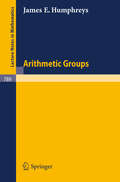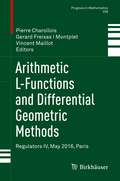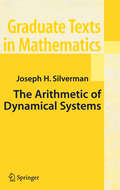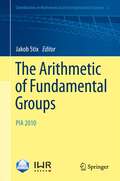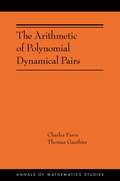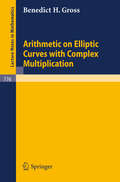- Table View
- List View
Arithmetic L-Functions and Differential Geometric Methods: Regulators IV, May 2016, Paris (Progress in Mathematics #338)
This book is an outgrowth of the conference “Regulators IV: An International Conference on Arithmetic L-functions and Differential Geometric Methods” that was held in Paris in May 2016. Gathering contributions by leading experts in the field ranging from original surveys to pure research articles, this volume provides comprehensive coverage of the front most developments in the field of regulator maps. Key topics covered are:• Additive polylogarithms• Analytic torsions• Chabauty-Kim theory• Local Grothendieck-Riemann-Roch theorems• Periods• Syntomic regulatorThe book contains contributions by M. Asakura, J. Balakrishnan, A. Besser, A. Best, F. Bianchi, O. Gregory, A. Langer, B. Lawrence, X. Ma, S. Müller, N. Otsubo, J. Raimbault, W. Raskin, D. Rössler, S. Shen, N. Triantafi llou, S. Ünver and J. Vonk.
Arithmetic Moduli of Elliptic Curves. (AM-108), Volume 108 (PDF)
by Nicholas M. Katz Barry MazurThis work is a comprehensive treatment of recent developments in the study of elliptic curves and their moduli spaces. The arithmetic study of the moduli spaces began with Jacobi's "Fundamenta Nova" in 1829, and the modern theory was erected by Eichler-Shimura, Igusa, and Deligne-Rapoport. In the past decade mathematicians have made further substantial progress in the field. This book gives a complete account of that progress, including not only the work of the authors, but also that of Deligne and Drinfeld.
Arithmetic Ninja for Ages 10-11: Maths activities for Year 6
by Andrew Jennings Paul TuckerArithmetic Ninja for Ages 10-11 is the essential photocopiable maths resource for every Year 6 classroom from Andrew Jennings, the creator of Vocabulary Ninja, Comprehension Ninja and Write Like a Ninja.Split into 38 weeks, this book features over 680 question cards and is fully aligned to the Key Stage 2 National Curriculum for mathematics. With activities for each day of the week plus a bonus challenge, this book is the perfect resource for daily maths practice and quick lesson starters.The exercises in this book get progressively harder each week, and are divided into three Ninja levels to ensure differentiation. There are answers at the back to help with marking and cutting lines on each page so the activities can easily be cut out and stuck in exercise books.Perfect for SATs preparation, the multiplication tables check and mental maths practice, this book is ideal for busy primary teachers who only want to visit the photocopier once a week. The resources are flexible and high-quality, and will ensure all pupils are maths Ninjas by the end of the year.For more must-have Ninja books by Andrew Jennings (@VocabularyNinja), check out Vocabulary Ninja, Comprehension Ninja, Write Like a Ninja and Times Tables Ninja.
Arithmetic Ninja for Ages 5-6: Maths activities for Year 1
by Andrew Jennings Sarah FarrellArithmetic Ninja for Ages 5-6 is the essential photocopiable maths resource for every Year 1 classroom from Andrew Jennings, the creator of Vocabulary Ninja, Comprehension Ninja and Write Like a Ninja.Split into 38 weeks, this book features over 680 question cards and is fully aligned to the Key Stage 1 National Curriculum for mathematics. With activities for each day of the week plus a bonus challenge, this book is the perfect resource for daily maths practice and quick lesson starters.The exercises in this book get progressively harder each week, and are divided into three Ninja levels to ensure differentiation. There are answers at the back to help with marking and cutting lines on each page so the activities can easily be cut out and stuck in exercise books.Perfect for SATs preparation, the multiplication tables check and mental maths practice, this book is ideal for busy primary teachers who only want to visit the photocopier once a week. The resources are flexible and high-quality, and will ensure all pupils are maths Ninjas by the end of the year.For more must-have Ninja books by Andrew Jennings (@VocabularyNinja), check out Vocabulary Ninja, Comprehension Ninja, Write Like a Ninja and Times Tables Ninja.
Arithmetic Ninja for Ages 6-7: Maths activities for Year 2
by Andrew Jennings Sarah FarrellArithmetic Ninja for Ages 6-7 is the essential photocopiable maths resource for every Year 2 classroom from Andrew Jennings, the creator of Vocabulary Ninja, Comprehension Ninja and Write Like a Ninja.Split into 38 weeks, this book features over 680 question cards and is fully aligned to the Key Stage 1 National Curriculum for mathematics. With activities for each day of the week plus a bonus challenge, this book is the perfect resource for daily maths practice and quick lesson starters.The exercises in this book get progressively harder each week, and are divided into three Ninja levels to ensure differentiation. There are answers at the back to help with marking and cutting lines on each page so the activities can easily be cut out and stuck in exercise books.Perfect for SATs preparation, the multiplication tables check and mental maths practice, this book is ideal for busy primary teachers who only want to visit the photocopier once a week. The resources are flexible and high-quality, and will ensure all pupils are maths Ninjas by the end of the year.For more must-have Ninja books by Andrew Jennings (@VocabularyNinja), check out Vocabulary Ninja, Comprehension Ninja, Write Like a Ninja and Times Tables Ninja.
Arithmetic Ninja for Ages 7-8: Maths activities for Year 3
by Andrew Jennings Sarah FarrellArithmetic Ninja for Ages 7-8 is the essential photocopiable maths resource for every Year 3 classroom from Andrew Jennings, the creator of Vocabulary Ninja, Comprehension Ninja and Write Like a Ninja.Split into 38, this book features over 680 question cards and is fully aligned to the Key Stage 2 National Curriculum for mathematics. With activities for each day of the week plus a bonus challenge, this book is the perfect resource for daily maths practice and quick lesson starters.The exercises in this book get progressively harder each week, and are divided into three Ninja levels to ensure differentiation. There are answers at the back to help with marking and cutting lines on each page so the activities can easily be cut out and stuck in exercise books.Perfect for SATs preparation, the multiplication tables check and mental maths practice, this book is ideal for busy primary teachers who only want to visit the photocopier once a week. The resources are flexible and high-quality, and will ensure all pupils are maths Ninjas by the end of the year.For more must-have Ninja books by Andrew Jennings (@VocabularyNinja), check out Vocabulary Ninja, Comprehension Ninja, Write Like a Ninja and Times Tables Ninja.
Arithmetic Ninja for Ages 8-9: Maths activities for Year 4
by Andrew Jennings Sarah FarrellArithmetic Ninja for Ages 8-9 is the essential photocopiable maths resource for every Year 4 classroom from Andrew Jennings, the creator of Vocabulary Ninja, Comprehension Ninja and Write Like a Ninja.Split into 38 weeks, this book features over 680 question cards and is fully aligned to the Key Stage 2 National Curriculum for mathematics. With activities for each day of the week plus a bonus challenge, this book is the perfect resource for daily maths practice and quick lesson starters.The exercises in this book get progressively harder each week, and are divided into three Ninja levels to ensure differentiation. There are answers at the back to help with marking and cutting lines on each page so the activities can easily be cut out and stuck in exercise books.Perfect for SATs preparation, the multiplication tables check and mental maths practice, this book is ideal for busy primary teachers who only want to visit the photocopier once a week. The resources are flexible and high-quality, and will ensure all pupils are maths Ninjas by the end of the year.For more must-have Ninja books by Andrew Jennings (@VocabularyNinja), check out Vocabulary Ninja, Comprehension Ninja, Write Like a Ninja and Times Tables Ninja.
Arithmetic Ninja for Ages 9-10: Maths activities for Year 5
by Andrew Jennings Sarah FarrellArithmetic Ninja for Ages 9-10 is the essential photocopiable maths resource for every Year 5 classroom from Andrew Jennings, the creator of Vocabulary Ninja, Comprehension Ninja and Write Like a Ninja.Split into 38 weeks, this book features over 680 question cards and is fully aligned to the Key Stage 2 National Curriculum for mathematics. With activities for each day of the week plus a bonus challenge, this book is the perfect resource for daily maths practice and quick lesson starters.The exercises in this book get progressively harder each week, and are divided into three Ninja levels to ensure differentiation. There are answers at the back to help with marking and cutting lines on each page so the activities can easily be cut out and stuck in exercise books.Perfect for SATs preparation, the multiplication tables check and mental maths practice, this book is ideal for busy primary teachers who only want to visit the photocopier once a week. The resources are flexible and high-quality, and will ensure all pupils are maths Ninjas by the end of the year.For more must-have Ninja books by Andrew Jennings (@VocabularyNinja), check out Vocabulary Ninja, Comprehension Ninja, Write Like a Ninja and Times Tables Ninja.
The Arithmetic of Al-Uqlīdisī: The Story of Hindu-Arabic Arithmetic as told in Kitāb al-Fuṣūl fī al-Ḥisāb al-Hindī
by A.S. SaidanThe purpose of presenting this book to the scholarly world is twofold. In the first place, I wish to provide for the English reader a translation of the earliest extant Arabic work of Hindi arithmetic. It shows this system at its earliest stages and the first steps in its development, a subject not yet well known except for readers of some Arabic publications by the present writer. This book is therefore of particular importance for students of the history of mathematical techniques. The medieval author, AI-UqHdisI, was, it seems, not noticed by bibliographers; neither was his work, which lay hardly noticed by modern scholars until 1960 when I happened to see a microfilm copy of it in the Institute of Arabic Manu scripts in Cairo. A steady labour immediately followed to make a comparative study of the text together with over twenty other texts, some of them not yet known to scholars. This pursuit resulted in (i) a doctoral degree awarded to me in 1966 by the University of Khartoum, (ii) the publication of several texts in Arabic including the text here translated, and (iii) the publication of several articles in Arabic and English on the history of arithmetic in the Middle Ages. The second purpose of this book is to make the main results of my study available to the English reader.
Arithmetic of Complex Manifolds: Proceedings of a Conference held in Erlangen, FRG, May 27-31, 1988 (Lecture Notes in Mathematics #1399)
by Wolf P. Barth Herbert LangeIt was the aim of the Erlangen meeting in May 1988 to bring together number theoretists and algebraic geometers to discuss problems of common interest, such as moduli problems, complex tori, integral points, rationality questions, automorphic forms. In recent years such problems, which are simultaneously of arithmetic and geometric interest, have become increasingly important. This proceedings volume contains 12 original research papers. Its main topics are theta functions, modular forms, abelian varieties and algebraic three-folds.
The Arithmetic of Dynamical Systems (Graduate Texts in Mathematics #241)
by J.H. SilvermanThis book provides an introduction to the relatively new discipline of arithmetic dynamics. Whereas classical discrete dynamics is the study of iteration of self-maps of the complex plane or real line, arithmetic dynamics is the study of the number-theoretic properties of rational and algebraic points under repeated application of a polynomial or rational function. A principal theme of arithmetic dynamics is that many of the fundamental problems in the theory of Diophantine equations have dynamical analogs.This graduate-level text provides an entry for students into an active field of research and serves as a standard reference for researchers.
The Arithmetic of Elliptic Curves (Graduate Texts in Mathematics #106)
by Joseph H. SilvermanThe theory of elliptic curves is distinguished by its long history and by the diversity of the methods that have been used in its study. This book treats the arithmetic approach in its modern formulation, through the use of basic algebraic number theory and algebraic geometry. Following a brief discussion of the necessary algebro-geometric results, the book proceeds with an exposition of the geometry and the formal group of elliptic curves, elliptic curves over finite fields, the complex numbers, local fields, and global fields. Final chapters deal with integral and rational points, including Siegels theorem and explicit computations for the curve Y = X + DX, while three appendices conclude the whole: Elliptic Curves in Characteristics 2 and 3, Group Cohomology, and an overview of more advanced topics.
The Arithmetic of Elliptic Curves (Graduate Texts in Mathematics #106)
by Joseph H. SilvermanThe theory of elliptic curves is distinguished by its long history and by the diversity of the methods that have been used in its study. This book treats the arithmetic approach in its modern formulation, through the use of basic algebraic number theory and algebraic geometry. Following a brief discussion of the necessary algebro-geometric results, the book proceeds with an exposition of the geometry and the formal group of elliptic curves, elliptic curves over finite fields, the complex numbers, local fields, and global fields. Final chapters deal with integral and rational points, including Siegels theorem and explicit computations for the curve Y = X + DX, while three appendices conclude the whole: Elliptic Curves in Characteristics 2 and 3, Group Cohomology, and an overview of more advanced topics.
Arithmetic of Finite Fields: 6th International Workshop, WAIFI 2016, Ghent, Belgium, July 13-15, 2016, Revised Selected Papers (Lecture Notes in Computer Science #10064)
by Sylvain Duquesne and Svetla Petkova-NikovaThis book constitutes the thoroughly refereed post-workshop proceedings of the 6th International Workshop on the Arithmetic of Finite Field, WAIFI 2016, held in Ghent, Belgium, in July 2016. The 14 revised full papers and 3 invited talks presented were carefully reviewed and selected from 38 submissions. The papers are organized in topical sections on invited talks; elliptic curves; applications; irreducible polynomials; applications to cryptography; Boolean functions; cryptography; cryptography and Boolean functions.
The Arithmetic of Fundamental Groups: PIA 2010 (Contributions in Mathematical and Computational Sciences #2)
by Jakob StixIn the more than 100 years since the fundamental group was first introduced by Henri Poincaré it has evolved to play an important role in different areas of mathematics. Originally conceived as part of algebraic topology, this essential concept and its analogies have found numerous applications in mathematics that are still being investigated today, and which are explored in this volume, the result of a meeting at Heidelberg University that brought together mathematicians who use or study fundamental groups in their work with an eye towards applications in arithmetic. The book acknowledges the varied incarnations of the fundamental group: pro-finite, ℓ-adic, p-adic, pro-algebraic and motivic. It explores a wealth of topics that range from anabelian geometry (in particular the section conjecture), the ℓ-adic polylogarithm, gonality questions of modular curves, vector bundles in connection with monodromy, and relative pro-algebraic completions, to a motivic version of Minhyong Kim's non-abelian Chabauty method and p-adic integration after Coleman. The editor has also included the abstracts of all the talks given at the Heidelberg meeting, as well as the notes on Coleman integration and on Grothendieck's fundamental group with a view towards anabelian geometry taken from a series of introductory lectures given by Amnon Besser and Tamás Szamuely, respectively.
Arithmetic of Higher-Dimensional Algebraic Varieties (Progress in Mathematics #226)
by Bjorn Poonen Yuri TschinkelThis text offers a collection of survey and research papers by leading specialists in the field documenting the current understanding of higher dimensional varieties. Recently, it has become clear that ideas from many branches of mathematics can be successfully employed in the study of rational and integral points. This book will be very valuable for researchers from these various fields who have an interest in arithmetic applications, specialists in arithmetic geometry itself, and graduate students wishing to pursue research in this area.
The Arithmetic of Hyperbolic 3-Manifolds (Graduate Texts in Mathematics #219)
by Colin Maclachlan Alan W. ReidRecently there has been considerable interest in developing techniques based on number theory to attack problems of 3-manifolds; Contains many examples and lots of problems; Brings together much of the existing literature of Kleinian groups in a clear and concise way; At present no such text exists
The Arithmetic of Infinitesimals (Sources and Studies in the History of Mathematics and Physical Sciences)
by John WallisJohn Wallis (1616-1703) was the most influential English mathematician prior to Newton. He published his most famous work, Arithmetica Infinitorum, in Latin in 1656. This book studied the quadrature of curves and systematised the analysis of Descartes and Cavelieri. Upon publication, this text immediately became the standard book on the subject and was frequently referred to by subsequent writers. This will be the first English translation of this text ever to be published.
Arithmetic of p-adic Modular Forms (Lecture Notes in Mathematics #1304)
by Fernando Q. GouveaThe central topic of this research monograph is the relation between p-adic modular forms and p-adic Galois representations, and in particular the theory of deformations of Galois representations recently introduced by Mazur. The classical theory of modular forms is assumed known to the reader, but the p-adic theory is reviewed in detail, with ample intuitive and heuristic discussion, so that the book will serve as a convenient point of entry to research in that area. The results on the U operator and on Galois representations are new, and will be of interest even to the experts. A list of further problems in the field is included to guide the beginner in his research. The book will thus be of interest to number theorists who wish to learn about p-adic modular forms, leading them rapidly to interesting research, and also to the specialists in the subject.
The Arithmetic of Polynomial Dynamical Pairs: (AMS-214) (Annals of Mathematics Studies #401)
by Charles Favre Thomas GauthierNew mathematical research in arithmetic dynamicsIn The Arithmetic of Polynomial Dynamical Pairs, Charles Favre and Thomas Gauthier present new mathematical research in the field of arithmetic dynamics. Specifically, the authors study one-dimensional algebraic families of pairs given by a polynomial with a marked point. Combining tools from arithmetic geometry and holomorphic dynamics, they prove an “unlikely intersection” statement for such pairs, thereby demonstrating strong rigidity features for them. They further describe one-dimensional families in the moduli space of polynomials containing infinitely many postcritically finite parameters, proving the dynamical André-Oort conjecture for curves in this context, originally stated by Baker and DeMarco.This is a reader-friendly invitation to a new and exciting research area that brings together sophisticated tools from many branches of mathematics.
Arithmetic of Quadratic Forms (Springer Monographs in Mathematics #109)
by Goro ShimuraThis book is divided into two parts. The first part is preliminary and consists of algebraic number theory and the theory of semisimple algebras. There are two principal topics: classification of quadratic forms and quadratic Diophantine equations. The second topic is a new framework which contains the investigation of Gauss on the sums of three squares as a special case. To make the book concise, the author proves some basic theorems in number theory only in some special cases. However, the book is self-contained when the base field is the rational number field, and the main theorems are stated with an arbitrary number field as the base field. So the reader familiar with class field theory will be able to learn the arithmetic theory of quadratic forms with no further references.
Arithmetic on Elliptic Curves with Complex Multiplication (Lecture Notes in Mathematics #776)
by B.H. GrossArithmetic on Modular Curves (Progress in Mathematics #20)
by G. StevensOne of the most intriguing problems of modern number theory is to relate the arithmetic of abelian varieties to the special values of associated L-functions. A very precise conjecture has been formulated for elliptic curves by Birc~ and Swinnerton-Dyer and generalized to abelian varieties by Tate. The numerical evidence is quite encouraging. A weakened form of the conjectures has been verified for CM elliptic curves by Coates and Wiles, and recently strengthened by K. Rubin. But a general proof of the conjectures seems still to be a long way off. A few years ago, B. Mazur [26] proved a weak analog of these c- jectures. Let N be prime, and be a weight two newform for r 0 (N) . For a primitive Dirichlet character X of conductor prime to N, let i\ f (X) denote the algebraic part of L (f , X, 1) (see below). Mazur showed in [ 26] that the residue class of Af (X) modulo the "Eisenstein" ideal gives information about the arithmetic of Xo (N). There are two aspects to his work: congruence formulae for the values Af(X) , and a descent argument. Mazur's congruence formulae were extended to r 1 (N), N prime, by S. Kamienny and the author [17], and in a paper which will appear shortly, Kamienny has generalized the descent argument to this case.
Arithmetic Tales (Universitext)
by Olivier BordellèsNumber theory was once famously labeled the queen of mathematics by Gauss. The multiplicative structure of the integers in particular deals with many fascinating problems some of which are easy to understand but very difficult to solve. In the past, a variety of very different techniques has been applied to further its understanding.Classical methods in analytic theory such as Mertens’ theorem and Chebyshev’s inequalities and the celebrated Prime Number Theorem give estimates for the distribution of prime numbers. Later on, multiplicative structure of integers leads to multiplicative arithmetical functions for which there are many important examples in number theory. Their theory involves the Dirichlet convolution product which arises with the inclusion of several summation techniques and a survey of classical results such as Hall and Tenenbaum’s theorem and the Möbius Inversion Formula. Another topic is the counting integer points close to smooth curves and its relation to the distribution of squarefree numbers, which is rarely covered in existing texts. Final chapters focus on exponential sums and algebraic number fields. A number of exercises at varying levels are also included. Topics in Multiplicative Number Theory introduces offers a comprehensive introduction into these topics with an emphasis on analytic number theory. Since it requires very little technical expertise it will appeal to a wide target group including upper level undergraduates, doctoral and masters level students.
